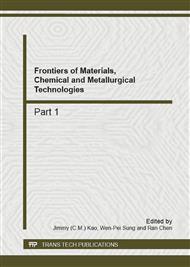p.317
p.322
p.326
p.330
p.334
p.341
p.345
p.349
p.353
Synthesis and Evaluation of Sulfonated Humic Acid-Acrylic Acid Graft Copolymer Applied as Dispersant in Coal-Water Slurry
Abstract:
A new type of graft copolymer, sulfonated humic acid-acrylic acid resin (SHA), was synthesized and developed as dispersant for highly-loaded coal water slurry (CWS) from Chinese Binchang coal. In this study, The formulation, stability and rheology of the slurry with SHA were investigated. The experimental results show that SHA can reduce effectively CWS viscosity at low dosage, and that the CWS with SHA has excellent stability within 48 h and exhibits shear-thinning apparent viscosity/shear rate behavior. Based on the above, SHA is a promising dispersant for highly-loaded CWS in the practical use in industry.
Info:
Periodical:
Pages:
334-337
Citation:
Online since:
October 2012
Authors:
Keywords:
Price:
Сopyright:
© 2012 Trans Tech Publications Ltd. All Rights Reserved
Share:
Citation:


